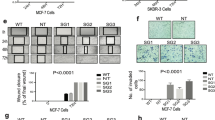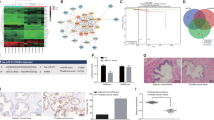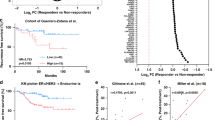Abstract
The female hormone progesterone (P4) promotes the expansion of stem-like cancer cells in estrogen receptor (ER)- and progesterone receptor (PR)-positive breast tumors. The expanded tumor cells lose expression of ER and PR, express the tumor-initiating marker CD44, the progenitor marker cytokeratin 5 (CK5) and are more resistant to standard endocrine and chemotherapies. The mechanisms underlying this hormone-stimulated reprogramming have remained largely unknown. In the present study, we investigated the role of microRNAs in progestin-mediated expansion of this dedifferentiated tumor cell population. We demonstrate that P4 rapidly downregulates miR-29 family members, particularly in the CD44+ cell population. Downregulation of miR-29 members potentiates the expansion of CK5+ and CD44+ cells in response to progestins, and results in increased stem-like properties in vitro and in vivo. We demonstrate that miR-29 directly targets Krüppel-like factor 4 (KLF4), a transcription factor required for the reprogramming of differentiated cells to pluripotent stem cells, and for the maintenance of breast cancer stem cells. These results reveal a novel mechanism, whereby progestins increase the stem cell-like population in hormone-responsive breast cancers, by decreasing miR-29 to augment PR-mediated upregulation of KLF4. Elucidating the mechanisms whereby hormones mediate the expansion of stem-like cells furthers our understanding of the progression of hormone-responsive breast cancers.
This is a preview of subscription content, access via your institution
Access options
Subscribe to this journal
Receive 50 print issues and online access
$259.00 per year
only $5.18 per issue
Buy this article
- Purchase on Springer Link
- Instant access to full article PDF
Prices may be subject to local taxes which are calculated during checkout








Similar content being viewed by others
References
Mulac-Jericevic B, Lydon JP, DeMayo FJ, Conneely OM . Defective mammary gland morphogenesis in mice lacking the progesterone receptor B isoform. Proc Natl Acad Sci 2003; 100: 9744–9749.
Ismail PM, Amato P, Soyal SM, DeMayo FJ, Conneely OM, O’Malley BW et al. Progesterone involvement in breast development and tumorigenesis—as revealed by progesterone receptor ‘knockout’ and ‘knockin’ mouse models. Steroids 2003; 68: 779–787.
Lange CA . Challenges to defining a role for progesterone in breast cancer. Steroids 2008; 73: 914–921.
Lydon JP, Ge G, Kittrell FS, Medina D, O’Malley BW . Murine mammary gland carcinogenesis is critically dependent on progesterone receptor function. Cancer Res 1999; 59: 4276–4284.
Magnusson C, Baron JA, Correia N, Bergström R, Adami HO, Persson I . Breast-cancer risk following long-term oestrogen- and oestrogen-progestin-replacement therapy. Int J Cancer 1999; 81: 339–344.
Ross RK, Paganini-Hill A, Wan PC, Pike MC . Effect of hormone replacement therapy on breast cancer risk: estrogen versus estrogen plus progestin. J Natl Cancer Inst 2000; 92: 328–332.
Schairer C, Lubin J, Troisi R, Sturgeon S, Brinton L, Hoover R . Menopausal estrogen and estrogen-progestin replacement therapy and breast cancer risk. JAMA 2000; 283: 485–491.
Asselin-Labat M-L, Vaillant F, Sheridan JM, Pal B, Wu D, Simpson ER et al. Control of mammary stem cell function by steroid hormone signalling. Nature 2010; 465: 798–802.
Joshi PA, Jackson HW, Beristain AG, Di Grappa MA, Mote PA, Clarke CL et al. Progesterone induces adult mammary stem cell expansion. Nature 2010; 465: 803–807.
Graham JD, Mote PA, Salagame U, van Dijk JH, Balleine RL, Huschtscha LI et al. DNA replication licensing and progenitor numbers are increased by progesterone in normal human breast. Endocrinology 2009; 150: 3318–3326.
Horwitz KB, Dye WW, Harrell JC, Kabos P, Sartorius CA . Rare steroid receptor-negative basal-like tumorigenic cells in luminal subtype human breast cancer xenografts. Proc Natl Acad Sci 2008; 105: 5774–5779.
Schramek D, Leibbrandt A, Sigl V, Kenner L, Pospisilik JA, Lee HJ et al. Osteoclast differentiation factor RANKL controls development of progestin-driven mammary cancer. Nature 2010; 468: 98–102.
Böcker W, Moll R, Poremba C, Holland R, Van Diest PJ, Dervan P et al. Common adult stem cells in the human breast give rise to glandular and myoepithelial cell lineages: a new cell biological concept. Lab Invest 2002; 82: 737–746.
Lim E, Vaillant F, Wu D, Forrest NC, Pal B, Hart AH et al. Aberrant luminal progenitors as the candidate target population for basal tumor development in BRCA1 mutation carriers. Nat Med 2009; 15: 907–913.
Haughian JM, Pinto MP, Harrell JC, Bliesner BS, Joensuu KM, Dye WW et al. Maintenance of hormone responsiveness in luminal breast cancers by suppression of Notch. Proc Natl Acad Sci USA 2012; 109: 2742–2747.
Kabos P, Haughian JM, Wang X, Dye WW, Finlayson C, Elias A et al. Cytokeratin 5 positive cells represent a steroid receptor negative and therapy resistant subpopulation in luminal breast cancers. Breast Cancer Res Treatment 2010; 128: 45–55.
Shcherbata HR, Hatfield S, Ward EJ . The MicroRNA pathway plays a regulatory role in stem cell division. Cell Cycle 2006; 5: 172–175.
Zhang J, Luo N, Luo Y, Peng Z, Zhang J, Li S . microRNA-150 inhibits human CD133-positive liver cancer stem cells through negative regulation of the transcription factor c-Myb. Int J Oncol 2011; 40: 747–756.
Yu F, Deng H, Yao H, Liu Q, Su F, Song E . Mir-30 reduction maintains self-renewal and inhibits apoptosis in breast tumor-initiating cells. Oncogene 2010; 29: 4194–4204.
Howe EN, Cochrane DR, Richer JK . Targets of miR-200c mediate suppression of cell motility and anoikis resistance. Breast Cancer Res 2011; 13: R45.
Radisky DC . miR-200c at the nexus of epithelial-mesenchymal transition, resistance to apoptosis, and the breast cancer stem cell phenotype. Breast Cancer Res 2011; 13: 110.
Liu C, Kelnar K, Liu B, Chen X, Calhoun-Davis T, Li H et al. The microRNA miR-34a inhibits prostate cancer stem cells and metastasis by directly repressing CD44. Nat Med 2011; 17: 211–215.
Tessel MA, Krett NL, Rosen ST . Steroid receptor and microRNA regulation in cancer. Curr Opin Oncol 2010; 22: 592–597.
Cochrane DR, Cittelly DM, Richer JK . Steroid receptors and microRNAs: relationships revealed. Steroids 2011; 76: 1–10.
Cittelly DM, Das PM, Salvo VA, Fonseca JP, Burow ME, Jones FE . Oncogenic HER2{Delta}16 suppresses miR-15a/16 and deregulates BCL-2 to promote endocrine resistance of breast tumors. Carcinogenesis 2010; 31: 2049–2057.
Cittelly DM, Das PM, Spoelstra NS, Edgerton SM, Richer JK, Thor AD et al. Downregulation of miR-342 is associated with tamoxifen resistant breast tumors. Mol Cancer 2010; 9: 317.
Rao X, Di Leva G, Li M, Fang F, Devlin C, Hartman-Frey C et al. MicroRNA-221/222 confers breast cancer fulvestrant resistance by regulating multiple signaling pathways. Oncogene 2011; 30: 1082–1097.
Lin S-L, Chang DC, Chang-Lin S, Lin C-H, Wu DTS, Chen DT et al. Mir-302 reprograms human skin cancer cells into a pluripotent ES-cell-like state. RNA 2008; 14: 2115–2124.
Lin S-L, Chang DC, Lin C-H, Ying S-Y, Leu D, Wu DTS . Regulation of Somatic Cell Reprogramming Through Inducible Mir-302 Expression. Nucleic Acids Res 2011; 39: 1054–1065.
Cochrane DR, Jacobsen BM, Connaghan K, Howe EN, Bain DL, Richer JK . Progestin regulated miRNAs that mediate progesterone receptor action in breast cancer. Mol Cell Endocrinol 2012; 355: 15–24.
Wong C, Hou P, Tseng S, Chien C, Wu K, Chen H et al. Krüppel-like transcription factor 4 contributes to maintenance of telomerase activity in stem cells. Stem Cells 2010; 28: 1510–1517.
Yu F, Li J, Chen H, Fu J, Ray S, Huang S et al. Kruppel-like factor 4 (KLF4) is required for maintenance of breast cancer stem cells and for cell migration and invasion. Oncogene 2011; 30: 2161–2172.
Zhang P, Andrianakos R, Yang Y, Liu C, Lu W . Kruppel-like factor 4 (Klf4) prevents embryonic stem (ES) cell differentiation by regulating nanog gene expression. J Biol Chem 2010; 285: 9180–9189.
Liu H, Patel MR, Prescher JA, Patsialou A, Qian D, Lin J et al. Cancer stem cells from human breast tumors are involved in spontaneous metastases in orthotopic mouse models. Proc Natl Acad Sci USA 2010; 107: 18115–18120.
Nguyen T, Kuo C, Nicholl MB, Sim M-S, Turner RR, Morton DL et al. Downregulation of microRNA-29c is associated with hypermethylation of tumor-related genes and disease outcome in cutaneous melanoma. Epigenetics 2011; 6: 388–394.
Sengupta S, den Boon JA, Chen I-H, Newton MA, Stanhope SA, Cheng Y-J et al. MicroRNA 29c is down-regulated in nasopharyngeal carcinomas, up-regulating mRNAs encoding extracellular matrix proteins. Proc Natl Acad Sci 2008; 105: 5874–5878.
Fabbri M, Garzon R, Cimmino A, Liu Z, Zanesi N, Callegari E et al. MicroRNA-29 family reverts aberrant methylation in lung cancer by targeting DNA methyltransferases 3A and 3B. Proc Natl Acad Sci 2007; 104: 15805–15810.
Hwang H-W, Wentzel EA, Mendell JT . A hexanucleotide element directs microRNA nuclear import. Science 2007; 315: 97–100.
Mott JL, Kurita S, Cazanave SC, Bronk SF, Werneburg NW, Fernandez-Zapico ME . Transcriptional suppression of mir-29b-1/mir-29a promoter by c-Myc, hedgehog, and NF-kappaB. J Cell Biochem 2010; 110: 1155–1164.
Moore MR, Zhou J-L, Blankenship KA, Strobl JS, Edwards DP, Gentry RN . A sequence in the 5′ flanking region confers progestin responsiveness on the human c-myc gene. J Steroid Biochem Mol Biol 1997; 62: 243–252.
Takahashi K, Yamanaka S . Induction of pluripotent stem cells from mouse embryonic and adult fibroblast cultures by defined factors. Cell 2006; 126: 663–676.
Richer JK, Jacobsen BM, Manning NG, Abel MG, Wolf DM, Horwitz KB . Differential gene regulation by the two progesterone receptor isoforms in human breast cancer cells. J Biol Chem 2002; 277: 5209–5218.
Park S-Y, Lee JH, Ha M, Nam J-W, Kim VN . miR-29 miRNAs activate p53 by targeting p85[alpha] and CDC42. Nat Struct Mol Biol 2009; 16: 23–29.
Wellner U, Schubert J, Burk UC, Schmalhofer O, Zhu F, Sonntag A et al. The EMT-activator ZEB1 promotes tumorigenicity by repressing stemness-inhibiting microRNAs. Nat Cell Biol 2009; 11: 1487–1495.
Pekarsky Y, Santanam U, Cimmino A, Palamarchuk A, Efanov A, Maximov V et al. Tcl1 expression in chronic lymphocytic leukemia is regulated by miR-29 and miR-181. Cancer Res 2006; 66: 11590–11593.
Yanaihara N, Caplen N, Bowman E, Seike M, Kumamoto K, Yi M et al. Unique microRNA molecular profiles in lung cancer diagnosis and prognosis. Cancer Cell 2006; 9: 189–198.
Iorio MV, Ferracin M, Liu C-G, Veronese A, Spizzo R, Sabbioni S et al. MicroRNA gene expression deregulation in human breast cancer. Cancer Res 2005; 65: 7065–7070.
Zhu M, Yi M, Kim CH, Deng C, Li Y, Medina D et al. Integrated miRNA and mRNA expression profiling of mouse mammary tumor models identifies miRNA signatures associated with mammary tumor lineage. Genome Biol 2011; 12: R77.
Blenkiron C, Goldstein LD, Thorne NP, Spiteri I, Chin S-F, Dunning MJ et al. MicroRNA expression profiling of human breast cancer identifies new markers of tumor subtype. Genome Biol 2007; 8: R214.
Zhang Z, Zou J, Wang G-K, Zhang J-T, Huang S, Qin Y-W et al. Uracils at nucleotide position 9-11 are required for the rapid turnover of miR-29 family. Nucleic Acids Res 2011; 39: 4387–4395.
Yang C-S, Li Z, Rana TM . microRNAs modulate iPS cell generation. RNA. 2011; 17: 1451–1460.
Sridharan R, Tchieu J, Mason MJ, Yachechko R, Kuoy E, Horvath S et al. Role of the murine reprogramming factors in the induction of pluripotency. Cell 2009; 136: 364–377.
Liu R, Zhou Z, Zhao D, Chen C . The induction of KLF5 transcription factor by progesterone contributes to progesterone-induced breast cancer cell proliferation and dedifferentiation. Mol Endocrinol 2011; 25: 1137–1144.
Sartorius CA, Harvell DME, Shen T, Horwitz KB . Progestins initiate a luminal to myoepithelial switch in estrogen-dependent human breast tumors without altering growth. Cancer Res 2005; 65: 9779–9788.
Bu W, Chen J, Morrison GD, Huang S, Creighton CJ, Huang J et al. Keratin 6a marks mammary bipotential progenitor cells that can give rise to a unique tumor model resembling human normal-like breast cancer. Oncogene 2011; 30: 4399–4409.
Acknowledgements
We thank the University of Colorado Cancer Center Cytometry and Cell Sorting Shared Resource Facility supported by P30CA046934. The human CK5 promoter (KRT5) was a gift from Elaine Fuchs (The Rockefeller University). NIH F31CA165668-01 supported ENH. NIH RO1CA140985 supported CAS. DOD BCRP Postdoctoral Fellowship W81XWH-11-1-0101 (DMC) and DOD Idea Award BCRP W81XWH-11-1-0210 (CAS, JKR) supported this work.
DMC performed most of the studies. JFS, PH created BT474 stable cell lines and performed reverse-transcriptase PCRs in BT474 cells. ENH quantified immunofluorescence images. SDA created the KRT5-luciferase reporter. NSS performed IHC. DMC, JFS, CAS, BMJ and JKR contributed intellectual input towards the design, implementation and interpretation of results. DMC wrote the manuscript. BMJ, CAS, JKR provided editorial assistance. All authors read and approved the final manuscript.
Author information
Authors and Affiliations
Corresponding author
Ethics declarations
Competing interests
The authors declare no conflict of interest.
Additional information
Supplementary Information accompanies the paper on the Oncogene website
Rights and permissions
About this article
Cite this article
Cittelly, D., Finlay-Schultz, J., Howe, E. et al. Progestin suppression of miR-29 potentiates dedifferentiation of breast cancer cells via KLF4. Oncogene 32, 2555–2564 (2013). https://doi.org/10.1038/onc.2012.275
Received:
Revised:
Accepted:
Published:
Issue Date:
DOI: https://doi.org/10.1038/onc.2012.275
Keywords
This article is cited by
-
ESR1 mutant breast cancers show elevated basal cytokeratins and immune activation
Nature Communications (2022)
-
Spatial transcriptomics inferred from pathology whole-slide images links tumor heterogeneity to survival in breast and lung cancer
Scientific Reports (2020)
-
Regulation of breast cancer metastasis signaling by miRNAs
Cancer and Metastasis Reviews (2020)
-
HNRNPA2/B1 is upregulated in endocrine-resistant LCC9 breast cancer cells and alters the miRNA transcriptome when overexpressed in MCF-7 cells
Scientific Reports (2019)
-
Emerging ways to treat breast cancer: will promises be met?
Cellular Oncology (2018)



